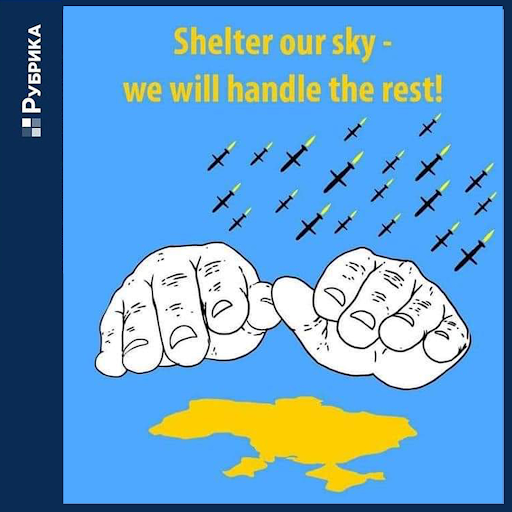Close the Sky: No-Fly Zones in Contemporary Military Conflicts
In 2011, Libyans protested for a No-Fly Zone to protect rebel forces from reprisals from Muammar Gaddafi’s government amid the turmoil of the Arab Spring. Photo: Deutsche Welle; In 2022, protestors in the United States call for a No-Fly Zone over Ukraine. Photo: USA Today.
As pitched resistance continues in the war in Ukraine, Ukrainian activists and peace protestors around the world have called on NATO to counter the invasion in an ostensibly non-military manner, by “closing the sky,” or enforcing a no-fly zone over Ukrainian territory. In the event of an ongoing Russia advance, a no-fly zone could level the playing field by preventing extensive Russian air strikes on Ukrainian targets.
Ukrainian President Volodymyr Zelenskyy reportedly brought up his hope for a US-instituted no-fly zone while meeting with the US Senate via video link on Saturday. As it remains in the news and in policy debates, it is worth considering the recent history of no-fly zones in the regions where they have most recently been instituted: Iraq and Libya.
A no-fly zone (NFZ) is essentially a demilitarized zone for a territory’s airspace. Usually, a coalition of exterior nations (such as the UN) pledges to prevent any aircraft from flying over a war zone in order to prevent civilian casualties. No-fly zones require enforcement. If a military plane or drone violates the air exclusion zone, then the power enforcing the NFZ must decide whether or not to shoot it down, which could lead to significant civilian casualties on the ground.
The first NFZ was instituted by the US military and its British and French allies over Iraq during the Gulf War. It was intermittently enforced between 1991-2003. Across the decade, several Iraqi flights were shot down by coalition forces, but a lack of cooperation with other regional powers (namely, Turkey) meant that air strikes continued and supply routes remained open.
Bosnia’s Operation Deny Flight in 1993 was the first major NFZ to have been enforced by NATO, in response to a specific resolution passed by the UN Security Council. While that NFZ was considered an effective strategy to protect civilians from air strikes, while also minimizing NATO casualties, it was ultimately expanded into an all-out bombing campaign (Operation Deliberate Force).
In 2011, the United Nations instituted an NFZ over Libya, following a UNSC resolution which allowed UN members to use "all necessary measures" short of occupation to protect Libyan civilians. NATO, concurrent with the NFZ, launched a campaign of air strikes against purported military installations in Libya. In the end, Human Rights Watch estimated that at least 72 civilians were killed.
Notably, the US has never enacted a no-fly zone over Syria. In 2012, General Martin Dempsey, then the chairman of the Joint Chiefs of Staff, expressed concerns that an NFZ in Syria would require, at best, 70,000 full-time troops. President Obama, reportedly apprehensive to expand the US presence in yet another war, balked. Even when Syrian troops employed chemical weapons against civilians, further intervention was ultimately rejected due to the risk of escalation.
In 2015, Democratic presidential candidate Hillary Clinton sparked controversy by telling a reporter that she supported the prospective use of an NFZ in Syria. Diverting from what was then the policy of the Obama White House, she stated, "I personally would be advocating now for a no-fly zone and humanitarian corridors to try to stop the carnage on the ground and from the air, to try to provide some way to take stock of what’s happening, to try to stem the flow of refugees."
At that point, however, Russia's ties to Syrian President Bashar Al-Assad had expanded such that Russian air strikes were targeting not just military installations, but also civilians and hospitals in areas that opposed the dictator. Donald Trump argued that shooting down these planes would "lead to World War Three."
And, now, history repeats itself. The indiscriminate bombing of civilian targets from the air, a hallmark of Russian and pro-Assad military strategies in Syria, has been employed with increasing regularity in Ukrainian cities this week, with civilians killed in air strikes in Kyiv, Kharkiv, and Chernihev. Russian Foreign Minister Sergey Lavrov recently claimed, in a statement released by Russian state media, that Volodymyr Zelenskyy’s intent with regard to a no-fly zone is to “provoke a conflict between NATO and Russia.”
Russian President Vladimir Putin told a gathering of Aeroflot employees on Saturday that any country imposing a no-fly zone may induce “colossal and catastrophic consequences, not only for Europe, but also for the world.” It looks unlikely that that threat will ever be realized. Linda Thomas-Greenfield, US Ambassador to the UN, was firm in the early days of the invasion that “[w]e're not going to put American troops in danger. That means we're not going to put American troops in the air [either].”
A poster design popular among Ukrainian-Americans on social media, encouraging a NATO “no fly zone” over Ukraine. Graphic: Natalya Sokhatska via Instagram.


